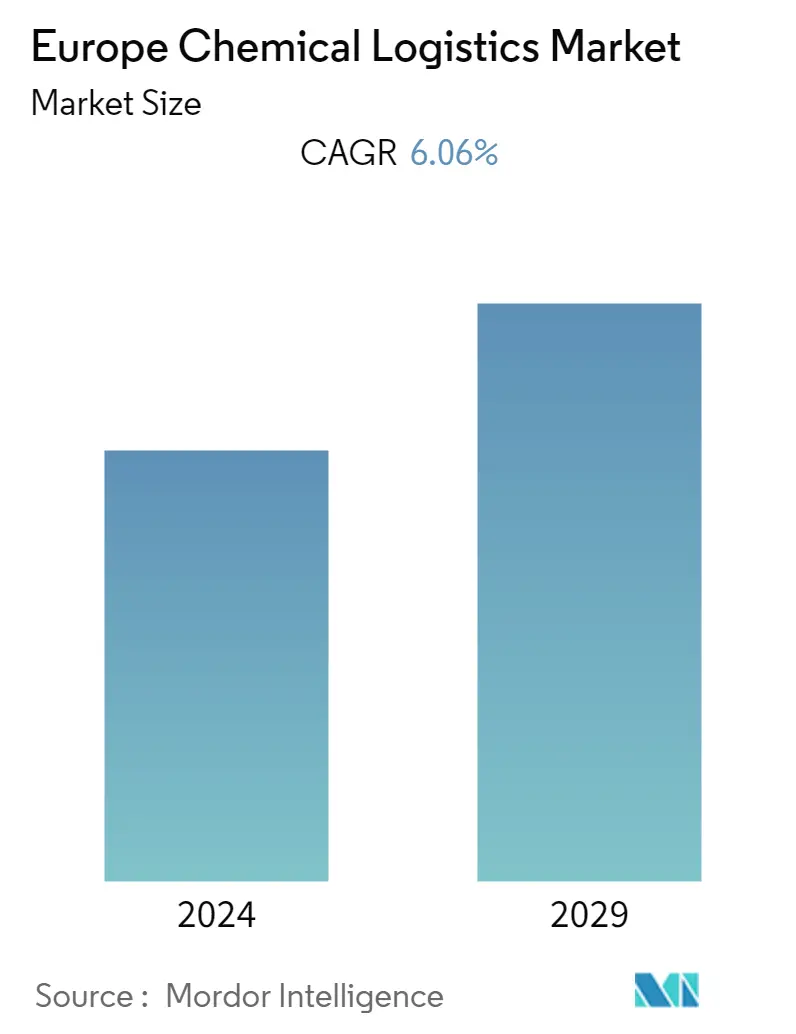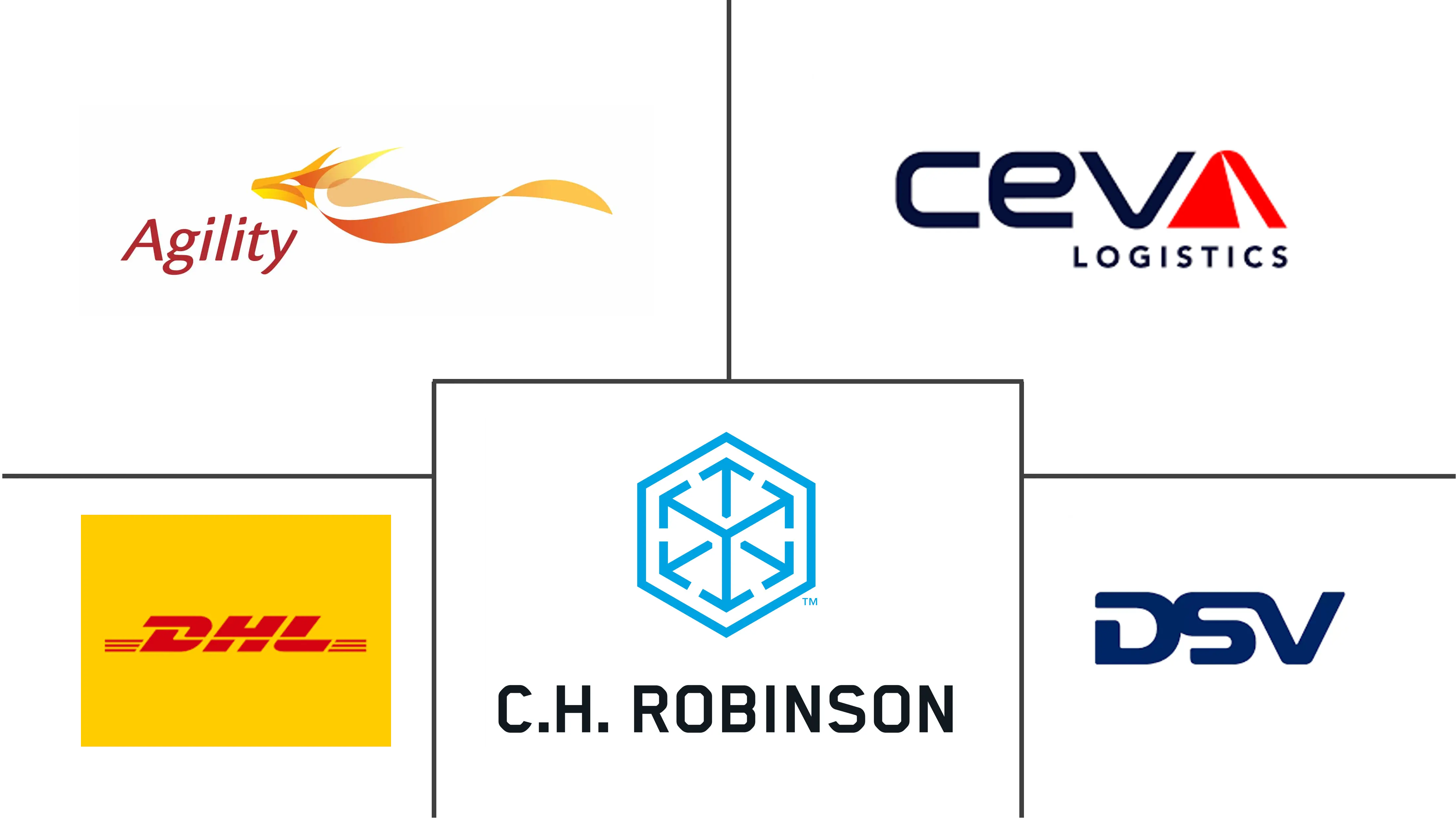Market Size of Europe Chemical Logistics Industry

| Study Period | 2019 - 2029 |
| Base Year For Estimation | 2023 |
| Forecast Data Period | 2024 - 2029 |
| Historical Data Period | 2019 - 2022 |
| CAGR | 6.06 % |
| Market Concentration | Low |
Major Players
*Disclaimer: Major Players sorted in no particular order |
Europe Chemical Logistics Market Analysis
The europe chemical logistics market size is expected to grow from USD 58.58 billion in 2023 to USD 78.62 billion by 2028, at a CAGR of 6.06% during the forecast period (2023-2028).
Logistics is an essential segment of supply chain management. A safe and reliable logistics system is an important aspect of the chemical industry. The manufacturing and consumption geography of the chemical industry are mostly separated. Therefore, logistics plays a part in the chemical industries' efficient, competitive, and sustainable market development.
The COVID-19 pandemic had a negative impact on the EU chemical industry. During the first half of 2020 (January-June), chemical output in the EU27 dropped by 5.2% compared to 2019 levels, with the lowest point reached in April 2020. In June 2020, a 2.9% output growth was registered compared to May 2020, showing some early and modest signs of recovery. Output results of the first four months (January to April) of 2021 increased by 5.2% compared to the same period in 2020. This was due to disruptions in the supply chain of raw materials. As the lockdowns were relaxed, there was a recovery in the EU chemical industry output in the early months of 2021.
The European chemical industry is in a strong position. It is a EUR 650 billion (USD 697 billion) industry made up of more than 28,000 companies, directly employing 1.2 million people and supporting a further 19 million jobs across its supply chain.
The chemical value chains are among the most resilient in Europe. The industry rose to expectations and delivered valuable support, such as with disinfectants supply. The chemical industry is Europe's biggest industrial consumer of electricity. As the impact of climate change takes increasing significance over the coming three decades, economies will need to switch to more renewable energy sources. Europe already has a keen lead in many areas of this technology. The electricity consumption by the EU27 chemical industry has fallen by 21% since 1990.
There has been an increase in chemical imports and exports, driving chemical logistics in the EU. In 2020, EU27 exported nearly EUR 169.3 billion (USD 180 billion) and imports worth almost EUR 128.8 billion (USD 137 billion), with chemical logistics playing a vital role in enhancing trade.
Europe has some of the biggest clusters of chemical parks. For example, Chempark is the largest chemical industry cluster in Europe, and every country has these clusters to transport raw materials, and end product transportation plays a vital role.
Europe Chemical Logistics Industry Segmentation
Chemical logistics refers to the shipment of bulk chemical products through a diverse range of equipment. These equipment are manufactured to maximize the variety of products transported through multimodal means.
The European chemical logistics market report provides insights into the market, like market overview, market dynamics, value chain/supply chain analysis, technological trends, investment scenarios, government regulations and initiatives, and insights into the 3PL market in Europe (market size and forecast). It also covers the impact of the COVID-19 pandemic on the chemical logistics market, and industry attractiveness, as determined by Porter's Five Forces Analysis.
The Europe Chemical Logistics Market is segmented by service (transportation, warehousing, distribution, inventory management, and other value-added services), mode of transportation (road, rail, sea, and pipeline), end user (pharmaceutical industry, cosmetics industry, oil and gas industry, specialty chemicals industry, and other end users (like coating industry)), and geography (Germany, United Kingdom, Netherlands, France, Italy, Spain, Poland, Belgium, Sweden, and Rest of Europe). The report offers market sizes and forecasts in value (USD) for all the above segments.
| By Service | |
| Transportation | |
| Warehousing, Distribution, and Inventory Management | |
| Other Value-added Services |
| By Mode of Transportation | |
| Road | |
| Rail | |
| Sea | |
| Pipeline |
| By End User | |
| Pharmaceutical Industry | |
| Cosmetics Industry | |
| Oil and Gas Industry | |
| Specialty Chemicals Industry | |
| Other End Users (like Coating Industry) |
| By Geography | |
| Germany | |
| United Kingdom | |
| Netherlands | |
| France | |
| Italy | |
| Spain | |
| Poland | |
| Belgium | |
| Sweden | |
| Rest of Europe |
Europe Chemical Logistics Market Size Summary
The European chemical logistics market is a critical component of the region's supply chain management, ensuring the efficient and safe transportation of chemicals across diverse manufacturing and consumption locations. This sector is vital for the chemical industry's competitive and sustainable growth, especially given the industry's reliance on complex value chains and the geographical separation of production and consumption sites. The market has shown resilience, recovering from the disruptions caused by the COVID-19 pandemic, which had initially led to a decline in chemical output. The industry's ability to adapt and support essential services, such as the supply of disinfectants, underscores its importance in Europe's industrial landscape. The European chemical industry, a significant consumer of electricity, is also at the forefront of transitioning to renewable energy sources, aligning with broader environmental goals.
The market is characterized by a fragmented and localized structure, with numerous regional and international players competing for market share. Key players include Agility Public Warehousing Co., CH Robinson Worldwide Inc., CEVA Logistics AG, and others, who are actively expanding their presence through mergers and acquisitions. The market's growth is further driven by increased chemical imports and exports, facilitated by major chemical parks and clusters across Europe. Countries like Germany, Belgium, and the Netherlands play pivotal roles in this trade, being top importers and exporters of chemical goods. The industry's ongoing structural transformation, prompted by rising competition and costs, highlights the need for continuous adaptation and innovation to maintain Europe's industrial competitiveness.
Europe Chemical Logistics Market Size - Table of Contents
-
1. MARKET INSIGHTS
-
1.1 Current Market Scenario
-
1.2 Value Chain/Supply Chain Analysis
-
1.3 Technological Trends
-
1.4 Investment Scenarios
-
1.5 Government Regulations and Initiatives
-
1.6 Insights into 3PL Market in Europe (Market Size and Forecast)
-
1.7 Impact of COVID-19 on Chemical Logistics Market
-
-
2. MARKET SEGMENTATION
-
2.1 By Service
-
2.1.1 Transportation
-
2.1.2 Warehousing, Distribution, and Inventory Management
-
2.1.3 Other Value-added Services
-
-
2.2 By Mode of Transportation
-
2.2.1 Road
-
2.2.2 Rail
-
2.2.3 Sea
-
2.2.4 Pipeline
-
-
2.3 By End User
-
2.3.1 Pharmaceutical Industry
-
2.3.2 Cosmetics Industry
-
2.3.3 Oil and Gas Industry
-
2.3.4 Specialty Chemicals Industry
-
2.3.5 Other End Users (like Coating Industry)
-
-
2.4 By Geography
-
2.4.1 Germany
-
2.4.2 United Kingdom
-
2.4.3 Netherlands
-
2.4.4 France
-
2.4.5 Italy
-
2.4.6 Spain
-
2.4.7 Poland
-
2.4.8 Belgium
-
2.4.9 Sweden
-
2.4.10 Rest of Europe
-
-
Europe Chemical Logistics Market Size FAQs
What is the current Europe Chemical Logistics Market size?
The Europe Chemical Logistics Market is projected to register a CAGR of 6.06% during the forecast period (2024-2029)
Who are the key players in Europe Chemical Logistics Market?
Agility Logistics, C. H. Robinson, CEVA Logistics, DHL and DSV are the major companies operating in the Europe Chemical Logistics Market.

